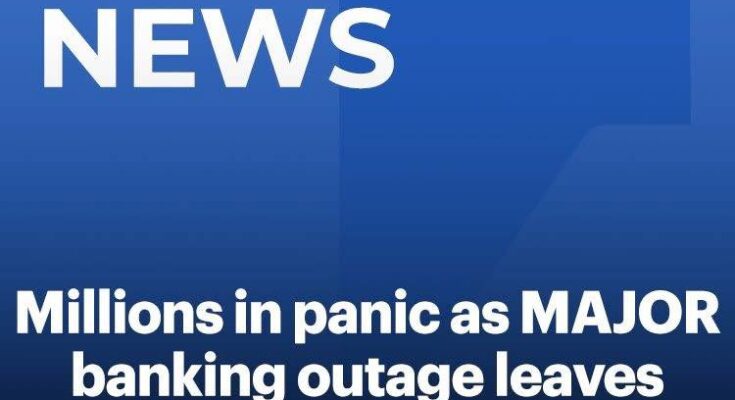Online payment concept. Over shoulder view of a woman accessing a mobile banking app on her smartphone, highlighting the ease of digital finance management. Internet bank, money transaction, fintech,
The financial disruption began in the early morning hours and quickly escalated into what industry experts are calling one of the most significant payment system failures in recent memory. As millions of Americans attempted to conduct their daily financial activities, they encountered error messages, failed transactions, and in some cases, money that simply vanished into the digital void.
The Scale of the Crisis
PayPal and Venmo, two of America’s most relied-upon digital payment platforms, experienced simultaneous major outages on Friday, effectively paralyzing financial transactions for hundreds of millions of users worldwide. The disruption, first detected by monitoring services at approximately 8:00am Eastern Time, created a domino effect that rippled through the entire digital payment ecosystem.
With PayPal boasting around 434 million active users globally and Venmo serving nearly 90 million users in the United States alone, the outage affected a user base larger than the population of most countries. The timing proved particularly devastating, as Friday morning represents one of the peak periods for digital transactions, with everything from payroll deposits to peer-to-peer payments typically processed during these hours.
Downdetector, the premier online service monitoring platform, registered thousands of complaints within the first hour of the outage, with reports flooding in from every major metropolitan area across the United States. The service’s heat maps showed concentrated problems in financial districts, college campuses, and urban centers where digital payments have become the primary method of transaction.
When Money Disappears: User Experiences
The outage created scenarios that seemed ripped from a digital nightmare, with users reporting money that vanished without a trace during attempted transfers. One particularly concerning case involved a PayPal user who described a chilling experience: “I sent someone $200, and the money was withdrawn from my account, but the other person didn’t receive it. There’s no record of the transaction on either end, and I have no idea where the money went.”
This type of “ghost transaction” represented one of the most troubling aspects of the outage, as it highlighted the potential for financial limbo when digital systems fail. Unlike traditional banking systems with extensive paper trails and regulatory oversight, peer-to-peer payment platforms operate in a more fluid digital environment where transaction failures can create temporary black holes for users’ funds.
Another user shared their frustration with basic platform functionality: “I can login to PayPal, but its not letting me make payments.” This partial functionality created additional confusion, as users could see their account balances and transaction history but were unable to complete new transactions, leading many to question whether the problem was with their accounts or the broader system.
The Paycheck Crisis
Perhaps the most devastating impact of the outage occurred among Venmo users who were expecting direct deposit paychecks. Friday morning is a critical time for many Americans, as it represents the end of the traditional pay period and the beginning of weekend financial planning. Numerous users reported that their scheduled paycheck deliveries failed to arrive, creating immediate financial stress for individuals living paycheck to paycheck.
“I was supposed to get my direct deposit this morning, but there’s nothing in my account,” reported one affected user. “I have bills due today and no way to pay them.” This scenario was repeated thousands of times across the country, as the outage coincided with one of the busiest direct deposit processing periods of the week.
The timing proved particularly problematic for gig economy workers, freelancers, and others who rely on rapid payment processing to maintain their cash flow. Many service workers who depend on tip payments through digital platforms found themselves unable to access their earnings, creating immediate hardship for some of the economy’s most vulnerable participants.
Technical Breakdown and System Failures
According to PayPal’s official service dashboard, the outage affected multiple critical systems simultaneously, suggesting a fundamental infrastructure failure rather than a simple service interruption. The company acknowledged disruptions across several key services, stating: “We are still observing impact to Retail Checkout, Online Checkout and Braintree in our production Environment.”
The mention of Braintree, PayPal’s payment processing subsidiary that handles transactions for major retailers and online merchants, indicated that the outage extended far beyond peer-to-peer payments. This disruption likely affected e-commerce transactions across thousands of websites that rely on PayPal’s infrastructure for payment processing.
PayPal’s technical team provided updates throughout the crisis, acknowledging the severity of the situation: “Our Technical teams are actively investigating and working to mitigate the impact as quickly as possible. We will continue to provide updates as the situation progresses.” However, the company’s inability to provide specific timelines for resolution added to user anxiety and frustration.
Business and Economic Impact
The outage’s effects extended far beyond individual users, creating significant challenges for businesses that have integrated PayPal and Venmo into their payment processing systems. Small businesses, in particular, found themselves unable to process online sales or accept digital payments, forcing many to resort to cash-only operations during peak business hours.
Restaurants, retail stores, and service providers that had embraced contactless payment solutions suddenly found themselves scrambling to accommodate customers who expected to pay digitally. Many establishments were forced to turn away customers who didn’t carry cash or traditional credit cards, resulting in immediate revenue losses during what should have been a profitable Friday.
The disruption also highlighted the vulnerability of businesses that had become overly dependent on a single payment processor. Companies that relied exclusively on PayPal for their e-commerce operations faced complete sales paralysis, while those with diversified payment options were able to continue operations with minimal disruption.
Regional and Demographic Variations
The outage’s impact varied significantly across different regions and demographic groups, reflecting the uneven adoption of digital payment technologies across American society. Urban areas and college campuses, where cashless transactions have become the norm, experienced more severe disruptions than rural communities where traditional payment methods remain common.
Younger users, who have grown up with digital payments as their primary financial tool, reported feeling particularly helpless during the outage. Many had never experienced a situation where their preferred payment method was completely unavailable, leading to widespread confusion about alternative options.
Conversely, older users who maintained traditional banking relationships and carried physical payment methods were often able to continue their daily activities with minimal disruption. This generational divide highlighted the potential risks of completely abandoning traditional payment infrastructure in favor of digital-only solutions.


